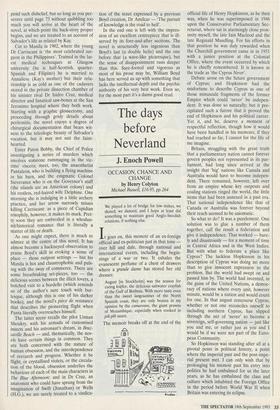Going on about her father's business
David Profumo
THE BLUE AFTERNOON by William Boyd Sinclair-Stevenson, f14.99, pp. 324 Castigating an author for not produc- ing a book that is as good as his last one is a critical cheap shot that gets nobody any- where, but when you are dealing with a novelist like the prodigious William Boyd it is difficult to avoid, because his last book, Brazzaville Beach, was a work of some bril- liance and his latest is not really in the same league.
The Blue Afternoon gets off to an awk- ward start, and its first 17 chapters are real- ly beating about the bush: the story opens in Los Angeles in 1936, and is narrated by Kay Fischer, an emancipated architect in her thirties whose personal life is sharply contrasted to the meticulous purism of her designs. She is still hung up on her ex- husband Philip (a feckless writer), and her former partner Meyersen has just cheated on her and demolished her dream-house. Then a stranger calling himself Salvador Carriscant turns up in the lobby and claims to be her long-lost father.
Boyd has always had the enviable talent of inspiring complete confidence in his reader, a crucial part of his wonderful nar- rative fluency: but for the first time I felt I was being shoehorned into one of his plots, because we are expected to believe that a tough-minded woman (who always believed her father was an English missionary who died when she was a baby) would up sticks and accompany a complete stranger on a quest to New Mexico, and then on to Lis- bon, almost no questions asked. I do not have sufficient height in my study to sus- pend such disbelief, but so long as you per- severe until page 73 without quibbling too much you will arrive at the heart of the novel, at which point the back-story proper begins, and we are treated to an account of Salvador's life as related by Kay.
Cut to Manila in 1902, where the young Dr Carriscant is 'the most celebrated sur- geon in the Philippines'. Trained in the lat- est medical techniques at Glasgow uniyersity (he is half-Scottish, quarter- Spanish and Filipino) he is married to Annaliese (Kay's mother) but their rela- tionship is as cold as one of the cadavers stored in the private dissection chamber of his sinister rival Dr Isidro Cruz, medical director and fanatical saw-bones at the San Jeronimo hospital where they both work. Starting with a graphic glossectomy, and proceeding through grisly details about peritonitis, the novel enjoys a degree of chirurgical documentation that bears wit- ness to the teleologic beauty of Salvador's vocation, but it may not suit the faint- hearted.
Enter Paton Bobby, the Chief of Police investigating a series of murders which involves someone rummaging in the vic- tims' viscera; meet, too, the anaesthetist Pantaleon, who is building a flying machine in his barn, and the enigmatic Colonel Sieverance who is on the Governor's staff (the islands are an American colony) and his restless, red-haired wife Delphine. One morning she is indulging in a little archery practice, and her arrow narrowly misses killing Carriscant: as a piece of Cupidian toxophily, however, it makes its mark. Pret- ty soon they are embroiled in a whodun- nit/historical romance that is literally a matter of life or death.
As one might expect, there is much to admire at the centre of this novel. It has almost become a hackneyed observation to praise Boyd's skill in evoking a sense of place — those outpost settings — but his Manila is hot and claustrophobic and puls- ing with the sway of commerce. There are some breathtaking set-pieces, too — the delicious scenes between the illicit lovers, a botched visit to a bordello (which reminds us of the author's sure touch with bur- lesque, although this is one of his darker books), and the novel's piece de resistance that describes the pioneering flight when Panta literally overreaches himself. The latter scene recalls the pilot Usman Shoukry, with his armada of customised insects and his astronaut's dream, in Braz- zaville Beach — and, thematically, the nov- els have certain things in common. They are both concerned with the nature of human obsession, and the interdependence of research and progress. Whether it be flight, or crystallised violets, or the circula- tion of the blood, obsession underlies the behaviour of each of the main characters in The Blue Afternoon: and in Dr Cruz, an anatomist who could have sprung from the imagination of Swift (Jonathan) or Wells (H.G.), we are surely treated to a vindica-
tion of the tenet expressed by a previous Boyd creation, Dr Amilcar — 'The pursuit of knowledge is the road to hell'.
In the end one is left with the impres- sion of an excellent centrepiece that is ill- served by its fore-and-after sections. The novel is structurally less ingenious than Boyd's last (a double helix) and the one before that (a wave-like picaresque), but the sense of disappointment runs deeper than this. Sure-footed and vigorous as most of his prose may be, William Boyd has here served us up with something that lacks the intellectual depth and the psychic authority of his very best work. Even so, for the most part it's a damn good read.



































































 Previous page
Previous page